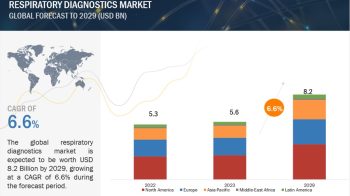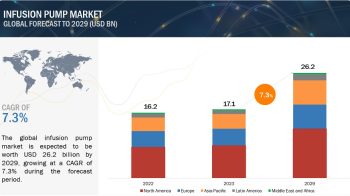Major Objectives of this Study:
# To define, describe, and forecast the organ preservation market based on solution, technique, organ type, end user, and region.
# To provide detailed information regarding the major factors influencing the growth of the market (drivers, restraints, opportunities, and challenges).
# To strategically analyze micromarkets1 with respect to individual growth trends, prospects, and contributions to the overall organ preservation market.
# To analyze market opportunities for stakeholders and provide details of the competitive landscape for market players.
# To estimate the market size and growth potential of the market segments with respect to five key regions-North America, Europe, Asia Pacific, Latin America, and the Middle East & Africa.
# To profile the key players operating in the organ preservation market and comprehensively analyze their revenue shares and core competencies.
# To track and analyze competitive developments such as product launches & approvals, partnerships, agreements, collaborations, expansions, joint ventures, and acquisitions in the organ preservation market.
# To benchmark players in the market using the proprietary “Competitive Leadership Mapping” framework, which analyzes market players on various parameters within the broad categories of business strategy and product offering.
Major Growth Driving Factors:
Growth in this market is majorly driven by the increasing incidence of multi-organ failure, the growing geriatric population, the rising number of organ transplants and organ donors, and increasing initiatives to encourage organ donations.
Download PDF Brochure@
https://www.marketsandmarkets.com/pdfdownloadNew.asp?id=261269915
Restraint: High cost of organ transplantation
Organ transplantation is a resource-intensive procedure involving highly paid doctors and surgeons, expensive transportation, and pricey drugs that make it expensive. The charges associated with inpatient care, organ procurement, preservation, post-operative recipient care, and anti-rejection medication increase the overall cost. Patients also need to incur additional costs of traveling, lodging, meals, hospital visits, and other medical testing expenditures for evaluation or follow-ups scheduled at the transplant center for an advised time period of medical supervision. For low-income patients, such expenses directly compete with expenditure on necessities such as food, clothing, and shelter, which often renders organ transplantation procedures inaccessible without external aid.
Challenge: Significant gap between the number of organs donated and organs required annually
Currently, there is a significant gap between the number of organs donated and the number of organs required. In the US, the total number of patients on the waiting list for organs was over 100,000 (106,588 as of January 2022). Only 41,354 transplants were performed by the end of 2021 (Source: Organ Procurement and Transplantation Network, US). The limited number of organs donated annually is mainly due to a lack of awareness related to organ donation, poor legislative measures, and the increased risk of organ trafficking. Governments of various countries are also implementing reformed laws (such as opt-out laws that presume every citizen is an organ donor except for some exempted conditions) and initiatives to encourage people to donate organs.
Opportunity: Growing healthcare investments
Governments across the globe are focusing on strengthening their healthcare infrastructures to provide enhanced healthcare facilities. For example, in India, the Brihanmumbai Municipal Corporation allocated nearly USD 924 million (INR 7,000 crore) or 15% of its 2022–2023 budget to upgrade health services and establish 100 health centers with more than 100 diagnostic tests for preventive and primary treatment in BMC areas. These infrastructural developments will lead to an increased number of hospitals that treat more brain-dead patients who might be suitable donors. The increasing number of testing laboratories will also improve the time concerned with donor-recipient cross-matching, subject profiling, genotyping, and other related diagnostic tests during the pre-transplantation period. These developments are expected to create new opportunities for the organ preservation market.
Recent Developments in the Global Organ Preservation Market:
# In 2021, Paragonix Technologies launched the LIVERguard Donor Liver Preservation System in both the US and Europe. This strategy expanded Paragonixs’ product offerings and strengthened their geographic presence.
# In 2021, XVIVO Perfusion partnered with Contatti Medical (Brazil) to expand its business and gain access to a comprehensive network of transplantation centers in Latin America’s largest country, Brazil.
# In 2021, Institut Georges Lopez (Igl) (France) expanded its presence by setting up a manufacturing facility in Cheyyar, Tamil Nadu, India, for manufacturing medical devices and solutions for flushing and preservation of organs.
# In 2021, Transmedics received premarket approval from the FDA for the OCS Heart System to be used with organs from donors after brain death (DBD).
# In 2020, Dr. Franz Köhler Chemie GmbH (Germany) entered into a joint venture with Melchers Group and CICEL (Germany) to establish Köhler Pharmaceuticals (Beijing) Ltd. in China for the distribution of Custodiol HTK solutions for cardiac and transplant surgery in the Chinese market.
Request Sample Pages@
https://www.marketsandmarkets.com/requestsampleNew.asp?id=261269915
Geographical Growth Dynamics:
North America accounted for the largest share of the organ preservation market in 2020
In 2020, North America accounted for the largest share of the market, followed by the Asia Pacific, Europe, Latin America, and the Middle East & Africa. The large share of this region can be attributed to factors such as the growing demand for and adoption of organ transplantation as a result of the rising number of chronic diseases such as end-stage diseases. The need for preservation solutions to protect the viability of organs in ex-vivo environments in the region is also a key factor contributing to the large share of North America in the organ preservation market.
End Users:
The organ transplant centers segment accounted for the largest share of the organ preservation market in 2020
Based on end user, the market is segmented into organ transplant centers, hospitals, and specialty clinics. The organ transplant centers segment accounted for the largest share of the organ preservation market in 2020. The increasing number of transplant centers across the globe is the key factor driving the acceptance of this end-user segment and propelling the market growth.


